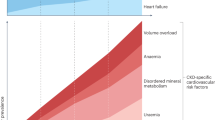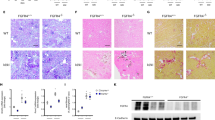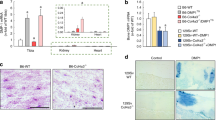Abstract
During the past few years, fibroblast growth factor 23 (FGF23) has emerged as a central player of disordered mineral metabolism in patients with chronic kidney disease (CKD). The physiological actions of FGF23 are to promote phosphaturia, decrease production of 1,25-dihydroxyvitamin D and suppress secretion of parathyroid hormone mediated through FGF receptors and the co-receptor Klotho. Recent epidemiological studies demonstrate strong associations between elevated FGF23 levels in patients with CKD and poor clinical outcomes. In patients with end-stage renal disease, markedly increased levels of FGF23 fail to exert Klotho-dependent effects owing to the absence of a functioning kidney and downregulation of the parathyroid complex of Klotho and FGF receptor 1. In this setting, FGF23 may exert a toxic effect on the cardiovascular system in a Klotho-independent manner. Future research should examine whether treatment to attenuate the pathogenic action of FGF23 provides survival benefits in patients with CKD.
This is a preview of subscription content, access via your institution
Access options
Subscribe to this journal
Receive 12 print issues and online access
$209.00 per year
only $17.42 per issue
Buy this article
- Purchase on Springer Link
- Instant access to full article PDF
Prices may be subject to local taxes which are calculated during checkout


Similar content being viewed by others
References
Coresh, J. et al. Prevalence of chronic kidney disease in the United States. JAMA 298, 2038–2047 (2007).
Imai, E. et al. Prevalence of chronic kidney disease in the Japanese general population. Clin. Exp. Nephrol. 13, 621–630 (2009).
Block, G. A. et al. Mineral metabolism, mortality, and morbidity in maintenance hemodialysis. J. Am. Soc. Nephrol. 15, 2208–2218 (2004).
Slatopolsky, E. & Delmez, J. A. Pathogenesis of secondary hyperparathyroidism. Nephrol. Dial. Transplant. 11 (Suppl. 3), 130–135 (1996).
Komaba, H. & Fukagawa, M. FGF23-parathyroid interaction: implications in chronic kidney disease. Kidney Int. 77, 292–298 (2010).
Gutiérrez, O. M. Fibroblast growth factor 23 and disordered vitamin D metabolism in chronic kidney disease: updating the “trade-off” hypothesis. Clin. J. Am. Soc. Nephrol. 5, 1710–1716 (2010).
Parker, B. D. et al. The associations of fibroblast growth factor 23 and uncarboxylated matrix Gla protein with mortality in coronary artery disease: the Heart and Soul Study. Ann. Intern. Med. 152, 640–648 (2010).
Seiler, S. et al. FGF-23 and future cardiovascular events in patients with chronic kidney disease before initiation of dialysis treatment. Nephrol. Dial. Transplant. 25, 3983–3989 (2010).
Isakova, T. et al. for the Chronic Renal Insufficiency Cohort (CRIC) Study Group. Fibroblast growth factor 23 and risks of mortality and end-stage renal disease in patients with chronic kidney disease. JAMA 305, 2432–2439 (2011).
Kendrick, J. et al. FGF-23 associates with death, cardiovascular events, and initiation of chronic dialysis. J. Am. Soc. Nephrol. 22, 1913–1922 (2011).
Fliser, D. et al. Fibroblast growth factor 23 (FGF23) predicts progression of chronic kidney disease: the Mild to Moderate Kidney Disease (MMKD) Study. J. Am. Soc. Nephrol. 18, 2600–2608 (2007).
Semba, R. D. et al. Serum fibroblast growth factor-23 and risk of incident chronic kidney disease in older community-dwelling women. Clin. J. Am. Soc. Nephrol. 7, 85–91 (2012).
Nakano, C. et al. Combined use of vitamin D status and FGF23 for risk stratification of renal outcome. Clin. J. Am. Soc. Nephrol. 7, 810–819 (2012).
Gutiérrez, O. M. et al. Fibroblast growth factor 23 and mortality among patients undergoing hemodialysis. N. Engl. J. Med. 359, 584–592 (2008).
Jean, G. et al. High levels of serum fibroblast growth factor (FGF)-23 are associated with increased mortality in long haemodialysis patients. Nephrol. Dial. Transplant. 24, 2792–2796 (2009).
Olauson, H. et al. Relation between serum fibroblast growth factor-23 level and mortality in incident dialysis patients: are gender and cardiovascular disease confounding the relationship? Nephrol. Dial. Transplant. 25, 3033–3038 (2010).
Faul, C. et al. FGF23 induces left ventricular hypertrophy. J. Clin. Invest. 121, 4393–4408 (2011).
Yamashita, T., Yoshioka, M. & Itoh, N. Identification of a novel fibroblast growth factor, FGF-23, preferentially expressed in the ventrolateral thalamic nucleus of the brain. Biochem. Biophys. Res. Commun. 277, 494–498 (2000).
ADHR Consortium. Autosomal dominant hypophosphataemic rickets is associated with mutations in FGF23. Nat. Genet. 26, 345–348 (2000).
Shimada, T. et al. Cloning and characterization of FGF23 as a causative factor of tumor-induced osteomalacia. Proc. Natl Acad. Sci. USA 98, 6500–6505 (2001).
Benet-Pagès, A. et al. FGF23 is processed by proprotein convertases but not by PHEX. Bone 35, 455–462 (2004).
Takeuchi, Y. et al. Venous sampling for fibroblast growth factor-23 confirms preoperative diagnosis of tumor-induced osteomalacia. J. Clin. Endocrinol. Metab. 89, 3979–3982 (2004).
Khosravi, A. et al. Determination of the elimination half-life of fibroblast growth factor-23. J. Clin. Endocrinol. Metab. 92, 2374–2377 (2007).
Shimada, T. et al. FGF-23 is a potent regulator of vitamin D metabolism and phosphate homeostasis. J. Bone Miner. Res. 19, 429–435 (2004).
Ben-Dov, I. Z. et al. The parathyroid is a target organ for FGF23 in rats. J. Clin. Invest. 117, 4003–4008 (2007).
Kurosu, H. et al. Regulation of fibroblast growth factor-23 signaling by Klotho. J. Biol. Chem. 281, 6120–6123 (2006).
Urakawa, I. et al. Klotho converts canonical FGF receptor into a specific receptor for FGF23. Nature 444, 770–774 (2006).
Bai, X., Dinghong, Q., Miao, D., Goltzman, D. & Karaplis, A. C. Klotho ablation converts the biochemical and skeletal alterations in FGF23 (R176Q) transgenic mice to a Klotho-deficient phenotype. Am. J. Physiol. Endocrinol. Metab. 296, E79–E88 (2009).
Nakatani, T. et al. In vivo genetic evidence for klotho-dependent, fibroblast growth factor 23 (Fgf23) -mediated regulation of systemic phosphate homeostasis. FASEB J. 23, 433–441 (2009).
Weber, T. J., Liu, S., Indridason, O. S. & Quarles, L. D. Serum FGF23 levels in normal and disordered phosphorus homeostasis. J. Bone Miner. Res. 18, 1227–1234 (2003).
Shimada, T. et al. Circulating fibroblast growth factor 23 in patients with end-stage renal disease treated by peritoneal dialysis is intact and biologically active. J. Clin. Endocrinol. Metab. 95, 578–585 (2010).
Levin, A. et al. Prevalence of abnormal serum vitamin D, PTH, calcium, and phosphorus in patients with chronic kidney disease: results of the study to evaluate early kidney disease. Kidney Int. 71, 31–38 (2007).
Shigematsu, T. et al. Possible involvement of circulating fibroblast growth factor 23 in the development of secondary hyperparathyroidism associated with renal insufficiency. Am. J. Kidney Dis. 44, 250–256 (2004).
Gutierrez, O. et al. Fibroblast growth factor-23 mitigates hyperphosphatemia but accentuates calcitriol deficiency in chronic kidney disease. J. Am. Soc. Nephrol. 16, 2205–2215 (2005).
Pereira, R. C. et al. Patterns of FGF-23, DMP1, and MEPE expression in patients with chronic kidney disease. Bone 45, 1161–1168 (2009).
Hasegawa, H. et al. Direct evidence for a causative role of FGF23 in the abnormal renal phosphate handling and vitamin D metabolism in rats with early-stage chronic kidney disease. Kidney Int. 78, 975–980 (2010).
Isakova, T. et al. Fibroblast growth factor 23 is elevated before parathyroid hormone and phosphate in chronic kidney disease. Kidney Int. 79, 1370–1378 (2011).
Ferrari, S. L., Bonjour, J. P. & Rizzoli, R. Fibroblast growth factor-23 relationship to dietary phosphate and renal phosphate handling in healthy young men. J. Clin. Endocrinol. Metab. 90, 1519–1524 (2005).
Burnett, S. M. et al. Regulation of C-terminal and intact FGF-23 by dietary phosphate in men and women. J. Bone Miner. Res. 21, 1187–1196 (2006).
Antoniucci, D. M., Yamashita, T. & Portale, A. A. Dietary phosphorus regulates serum fibroblast growth factor-23 concentrations in healthy men. J. Clin. Endocrinol. Metab. 91, 3144–3149 (2006).
Nishida, Y. et al. Acute effect of oral phosphate loading on serum fibroblast growth factor 23 levels in healthy men. Kidney Int. 70, 2141–2147 (2006).
Ito, N. et al. Effect of acute changes of serum phosphate on fibroblast growth factor (FGF)23 levels in humans. J. Bone Miner. Metab. 25, 419–422 (2007).
Oliveira, R. B. et al. Early control of PTH and FGF23 in normophosphatemic CKD patients: a new target in CKD-MBD therapy? Clin. J. Am. Soc. Nephrol. 5, 286–291 (2010).
Gonzalez-Parra, E. et al. Lanthanum carbonate reduces FGF23 in chronic kidney disease stage 3 patients. Nephrol. Dial. Transplant. 26, 2567–2571 (2011).
Yilmaz, M. I. et al. Comparison of calcium acetate and sevelamer on vascular function and fibroblast growth factor 23 in CKD patients: a randomized clinical trial. Am. J. Kidney Dis. 59, 177–185 (2012).
Isakova, T. et al. Pilot study of dietary phosphorus restriction and phosphorus binders to target fibroblast growth factor 23 in patients with chronic kidney disease. Nephrol. Dial. Transplant. 26, 584–591 (2011).
Urena Torres, P., Friedlander, G., de Vernejoul, M. C., Silve, C. & Prié, D. Bone mass does not correlate with the serum fibroblast growth factor 23 in hemodialysis patients. Kidney Int. 73, 102–107 (2008).
Bhan, I. et al. Post-transplant hypophosphatemia: tertiary 'hyper-phosphatoninism'? Kidney Int. 70, 1486–1494 (2006).
Evenepoel, P., Naesens, M., Claes, K., Kuypers, D. & Vanrenterghem, Y. Tertiary 'hyperphosphatoninism' accentuates hypophosphatemia and suppresses calcitriol levels in renal transplant recipients. Am. J. Transplant. 7, 1193–1200 (2007).
Kestenbaum, B. et al. Serum phosphate levels and mortality risk among people with chronic kidney disease. J. Am. Soc. Nephrol. 16, 520–528 (2005).
Menon, V. et al. Relationship of phosphorus and calcium-phosphorus product with mortality in CKD. Am. J. Kidney Dis. 46, 455–463 (2005).
Tonelli, M. et al. Relation between serum phosphate level and cardiovascular event rate in people with coronary disease. Circulation 112, 2627–2633 (2005).
Koh, N. et al. Severely reduced production of klotho in human chronic renal failure kidney. Biochem. Biophys. Res. Commun. 280, 1015–1020 (2001).
Fukagawa, M. & Kazama, J. J. With or without the kidney: the role of FGF23 in CKD. Nephrol. Dial. Transplant. 20, 1295–1298 (2005).
Kazama, J. J. et al. Pretreatment serum FGF-23 levels predict the efficacy of calcitriol therapy in dialysis patients. Kidney Int. 67, 1120–1125 (2005).
Nakanishi, S. et al. Serum fibroblast growth factor-23 levels predict the future refractory hyperparathyroidism in dialysis patients. Kidney Int. 67, 1171–1178 (2005).
Nishi, H. et al. Intravenous calcitriol therapy increases serum concentration of fibroblast growth factor-23 in dialysis patients with secondary hyperparathyroidism. Nephron Clin. Pract. 101, c94–c99 (2005).
Wesseling-Perry, K. et al. Calcitriol and doxercalciferol are equivalent in controlling bone turnover, suppressing parathyroid hormone, and increasing fibroblast growth factor-23 in secondary hyperparathyroidism. Kidney Int. 79, 112–119 (2011).
Hansen, D., Rasmussen, K., Pedersen, S. M., Rasmussen, L. M. & Brandi, L. Changes in fibroblast growth factor 23 during treatment of secondary hyperparathyroidism with alfacalcidol or paricalcitol. Nephrol. Dial. Transplant. 27, 2263–2269 (2012).
Wetmore, J. B., Liu, S., Krebill, R., Menard, R. & Quarles, L. D. Effects of cinacalcet and concurrent low-dose vitamin D on FGF23 levels in ESRD. Clin. J. Am. Soc. Nephrol. 5, 110–116 (2010).
Koizumi, M., Komaba, H., Nakanishi, S., Fujimori, A. & Fukagawa, M. Cinacalcet treatment and serum FGF23 levels in haemodialysis patients with secondary hyperparathyroidism. Nephrol. Dial. Transplant. 27, 784–790 (2012).
Sato, T. et al. Total parathyroidectomy reduces elevated circulating fibroblast growth factor 23 in advanced secondary hyperparathyroidism. Am. J. Kidney Dis. 44, 481–487 (2004).
Koiwa, F. et al. Sevelamer hydrochloride and calcium bicarbonate reduce serum fibroblast growth factor 23 levels in dialysis patients. Ther. Apher. Dial. 9, 336–339 (2005).
Shigematsu, T. & Negi, S. Combined therapy with lanthanum carbonate and calcium carbonate for hyperphosphatemia decreases serum FGF-23 level independently of calcium and PTH (COLC Study). Nephrol. Dial. Transplant. 27, 1050–1054 (2012).
Takeda, Y. et al. Effect of intravenous saccharated ferric oxide on serum FGF23 and mineral metabolism in hemodialysis patients. Am. J. Nephrol. 33, 421–426 (2011).
Lavi-Moshayoff, V., Wasserman, G., Meir, T., Silver, J. & Naveh-Many, T. PTH increases FGF23 gene expression and mediates the high-FGF23 levels of experimental kidney failure: a bone parathyroid feedback loop. Am. J. Physiol. Renal Physiol. 299, F882–F889 (2010).
López, I. et al. Direct and indirect effects of parathyroid hormone on circulating levels of fibroblast growth factor 23 in vivo. Kidney Int. 80, 475–482 (2011).
Liu, S. et al. Fibroblast growth factor 23 is a counter-regulatory phosphaturic hormone for vitamin D. J. Am. Soc. Nephrol. 17, 1305–1315 (2006).
Komaba, H. et al. Depressed expression of Klotho and FGF receptor 1 in hyperplastic parathyroid glands from uremic patients. Kidney Int. 77, 232–238 (2010).
Kumata, C. et al. Involvement of alpha-klotho and fibroblast growth factor receptor in the development of secondary hyperparathyroidism. Am. J. Nephrol. 31, 230–238 (2010).
Galitzer, H., Ben-Dov, I. Z., Silver, J. & Naveh-Many, T. Parathyroid cell resistance to fibroblast growth factor 23 in secondary hyperparathyroidism of chronic kidney disease. Kidney Int. 77, 211–218 (2010).
Canalejo, R. et al. FGF23 fails to inhibit uremic parathyroid glands. J. Am. Soc. Nephrol. 21, 1125–1135 (2010).
Hofman-Bang, J., Martuseviciene, G., Santini, M. A., Olgaard, K. & Lewin, E. Increased parathyroid expression of klotho in uremic rats. Kidney Int. 78, 1119–1127 (2010).
Martuseviciene, G., Hofman-Bang, J., Clausen, T., Olgaard, K. & Lewin, E. The secretory response of parathyroid hormone to acute hypocalcemia in vivo is independent of parathyroid glandular sodium/potassium-ATPase activity. Kidney Int. 79, 742–748 (2011).
Goetz, R. et al. Isolated C-terminal tail of FGF23 alleviates hypophosphatemia by inhibiting FGF23-FGFR-Klotho complex formation. Proc. Natl Acad. Sci. USA 107, 407–412 (2010).
Isakova, T. et al. Phosphorus binders and survival on hemodialysis. J. Am. Soc. Nephrol. 20, 388–396 (2009).
Wetmore, J. B. et al. Elevated FGF23 levels are associated with impaired calcium-mediated suppression of PTH in ESRD. J. Clin. Endocrinol. Metab. 96, E57–E64 (2011).
Okuno, S. et al. Relationship between parathyroid gland size and responsiveness to maxacalcitol therapy in patients with secondary hyperparathyroidism. Nephrol. Dial. Transplant. 18, 2613–2621 (2003).
Komaba, H. et al. Cinacalcet effectively reduces parathyroid hormone secretion and gland volume regardless of pretreatment gland size in patients with secondary hyperparathyroidism. Clin. J. Am. Soc. Nephrol. 5, 2305–2314 (2010).
Teng, M. et al. Activated injectable vitamin D and hemodialysis survival: a historical cohort study. J. Am. Soc. Nephrol. 16, 1115–1125 (2005).
Author information
Authors and Affiliations
Contributions
Both authors contributed equally to discussion of content for the article, researching data to include in the manuscript and reviewing and editing of the manuscript before submission.
Corresponding author
Ethics declarations
Competing interests
H. Komaba has received speakers bureau honoraria from Bayer Yakuhin, Chugai Pharmaceutical and Kyowa Hakko Kirin. M. Fukagawa has received speakers bureau honoraria and grant/research support from Bayer Yakuhin, Chugai Pharmaceutical and Kyowa Hakko Kirin.
Rights and permissions
About this article
Cite this article
Komaba, H., Fukagawa, M. The role of FGF23 in CKD—with or without Klotho. Nat Rev Nephrol 8, 484–490 (2012). https://doi.org/10.1038/nrneph.2012.116
Published:
Issue Date:
DOI: https://doi.org/10.1038/nrneph.2012.116
This article is cited by
-
Identifying individuals at risk of needing CKD associated medications in a European kidney disease cohort
BMC Nephrology (2024)
-
Associations between anemia and FGF23 in the CKiD study
Pediatric Nephrology (2024)
-
Association between serum phosphate levels and anemia in non-dialysis patients with chronic kidney disease: a retrospective cross-sectional study from the Fuji City CKD Network
BMC Nephrology (2023)
-
High pretransplant FGF23 level is associated with persistent vitamin D insufficiency and poor graft survival in kidney transplant patients
Scientific Reports (2023)
-
Roles of PTH and FGF23 in kidney failure: a focus on nonclassical effects
Clinical and Experimental Nephrology (2023)



